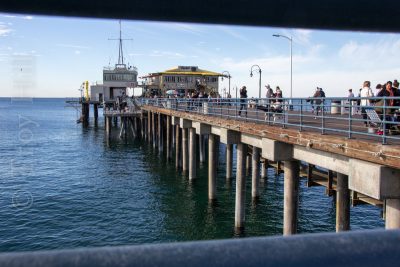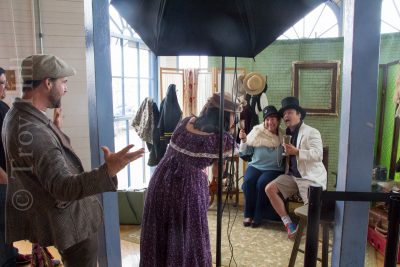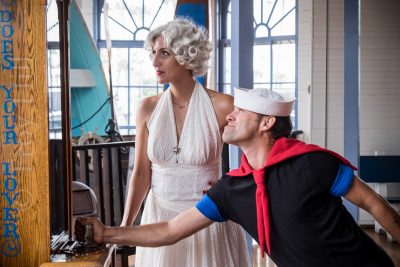The dapper young man twirled his cane. It’s sleek black line, tipped with white, whirling and spinning as he waddled, then sidled up to the doorway. He stuck his bowler capped head around the corner of the doorjamb. His head darted left and right. He quickly thrust his body into the opening. Back up against the door frame, legs crossed at the ankles. Striking a pose. He leaned casually on his cane, waiting to be noticed.
Outside the door, two men caught the sudden flash of movement from the corners of their eyes. They glanced over at the snappily dressed figure, with baggy dress slacks, grey vest over a white shirt with its collar sticking straight up. A black straight tie loosely closed the collar and descended the gent’s chest to disappear into the vest.
Once noticed by the men outside the door, he spun quickly. His shoulders shrugged. He was upright. Loose from the doorframe, he posed again, leaning on his cane. He was moving again. Mad dashes of movement. Punctuated with pauses for those observing to see the entirety of his performance. He’d stay in the pose until recognition dawned on the observer. Another eruption of movement. A few steps, a cane twirl. And he was inside the building again.

Spying my camera, he attempted to strike a pose. Elbow out to lean on the railing that ran around the room, separating the pedestrians from the center of the building. He crossed one leg over the other his other leg, one foot pointing down at the floor as he stood on the other foot and leaned on the railing.
And missed. His bushy black eyebrows arched up and his lips rounded in mock surprise as he slumped, then caught himself. Elbow out, he leaned again. And missed again. His black mustache, barely wider than two fingers side by side, danced in mock surprise as he missed a third time and caught himself. Finally, he balanced on one foot, and leaned casually on the railing, ready for me to press the shutter release and capture his image, not on the celluloid of old, but as digital pixels in 21st Century electronic media.
A Pier Rises
Santa Monica, California had a sewage problem. The town’s solution of what to do with the raw sewage a century or so ago would create one of Southern California’s most popular icons, which would be frequented by some of the area’s notable celebrities, such as silent film star Charlie Chaplin.
Charles Looff had relocated his family from Rhode Island to the burgeoning and bustling environs of Southern California just after the time that Santa Monica completed their 1,600-foot long solution to the sewage problem. The municipal pier carried a pipeline to dump the fast-growing town’s sewage out into the harbor, where it would be carried away by the tide. The structure’s grand opening with glorious ceremonies occurred on September 9, 1909. Santa Monica’s beach was already well regarded for recreation and the new concrete structure of the pier was attracting business speculators.
Looff emigrated to the USA in 1870 at the age of 18 from his native Denmark. Landing in Brooklyn, New York, he soon found employment as a furniture carver. His passion lay in finding and revealing the animals hiding in the wooden scraps he’d bring home from the furniture factory. Six years after he arrived in the US, his initial carousel was completed and placed as the first on Coney Island. He opened his own factory specializing in hand carved Carousels. His work graced amusement venues along the east coast, including Rhode Island, Atlantic City, and others in Coney Island.
Leaving his grown children behind to manage the business along the East Coast, Looff relocated to Long Beach in 1910 and began constructing and selling carousels along the country’s west coast. Looff’s hand-carved animals circling on their ornate “race tracks” spinning endlessly to organ music began appearing in beach communities along the coast. Looff was well regarded as an amusement entrepreneur with his carousel factories, and interest in The Pike, Long Beach’s beachside amusement area.

In Santa Monica, rival business interests were vying for the opportunity to tap into the growing recreation activities along California’s attractive coastline. To the south of Santa Monica, the Ocean Park area was a bustling hub of amusement piers, dance halls, and other entertainment. But, near Santa Monica’s new pier at the foot of Colorado Avenue, where US Route 66 would eventually end later in the century, there was a vacuum of amusement options. A short walking and fishing pier had been built on the northern side of Santa Monica in 1898 but did little to attract more than the locals interested in a stroll or fishing. The new 1,600-foot long Municipal pier gave the townsfolk another, a much longer avenue for strolling and casting a line into the water. But, there was a void of the trendy amusement activities that could be found farther south.
Edwin Benjamin and B.N. Moss owned seafront just to the south of the Municipal Pier, and Carl F. Schrader owned land to the north of the pier. Two months after receiving clearance from the US Engineer to build a 700-foot long amusement pier on their property, Benjamin and Moss sold their interest to Looff. The carousel maker and amusement specialist announced that he had selected Santa Monica due to its beach and higher end residents and clientele. His sons, Arthur, a civil engineer, and William arrived in Santa Monica to oversee the construction of the pleasure pier.
Meanwhile, Benjamin and Moss worked to upgrade the rest of their property, adjacent to what they had sold to Looff, to extend the Pacific Electric’s trolley rail line to the oceanfront. The rail line extension allowed Looff to easily move supplies for the construction. Supply ships brought in lumber for the construction. A dockworkers strike that spring threatened to slow construction, but was avoided by sailors dumping the lumber in bundles over the side of their ships, and barges pulling the lumber to the construction site. Looff had purchased all of the creosote-treated wooden pilings in Southern California – which had originally been slated for the Hammond Lumber company’s own pier that was to be built in San Pedro. Additional pilings from farther north were also brought in for the project.
In addition to using the new technology of creosote-treated lumber to resist rot and destruction by the water and sea life, the Looffs designed a new model of piledriver for driving the treated lumber deep into the harbor’s floor. Previous pile drivers used brute force of heavyweights dropped over and over onto the wood to wedge them into the rock below the compacted sand. Looff’s new design used pressurized water jets to loosen the sand as the wooden pilings were driven down into the soil. Arthur, who had managed many of his father’s construction projects, and his construction crew began to drive the piles on Saturday, March 25th.
Construction proceeded quickly, once the rail line, pile driver, lumber and talent all came together. But, a further wrinkle developed when rival businessman Carl F. Schrader attempted to get a slice of the amusement action. He worked with local morality factions in order to drive a wedge between Looff and the city’s Planning Commission who were overseeing the pier project. A proposal was debated as to whether the Loof pier, being built immediately adjacent to the Municipal Pier, would be allowed to connect to the city’s structure, or, whether a gap of up to 20 feet should be maintained. They were able to force Looff to agree to restrictions against gambling and alcohol consumption on the pleasure pier. Finally, on May 29 of 1916, Looff was awarded the franchise for the pier amusements for the next 20 years, and allowed to connect the two piers.

June 7th marked the day the Looff factory delivered the first carved and painted animals for the new carousel to be assembled in the new Looff Hippodrome.
The building, combined Byzantine, Moorish and California styles of architecture. A central 64-foot-high dome was surrounded by four turreted towers, one at each corner of the building. Offices were constructed on the second floor of the building, which would later be used as living space and converted to apartments.
A week later, on the weekend of June 12, 1916, the building’s wide doors, resembling multi-paned windows, were raised, and the notes of organ music from the newly constructed building would thunder up the rise and into Santa Monica. Inside the building, horses, and a few types of other animals, hand carved and painted in the Looff factory, ran an endless race in circles, never varying in position, none ever winning, as Santa Monicans and other Angelenos crowded the building for their chance to ride. The Looff Hippodrome – a combination of two Greek words Hippos for “Horse” and Drome for “Course” or Horse racing course – was open for business.
A Century Later
Over time, Los Angeles “nobility” such as Silent film star Charlie Chaplin, Starlet Marilyn Monroe, and even star of the ink and paper comic pages, Popeye would be part of the lore of the pier.
Jim Harris, the official historian of the Santa Monica Pier, dressed in spiffy ensemble outfit reminiscent of the early 1900s – vest, bow tie and straw hat welcomed Santa Monica’s mayor to slice a cake with the 100 years emblem commemorating the birth of the pier. Docents – tour guides who give historical talks on the history of the pier echoed Harris’ wardrobe choices, while photographers with a modern digital camera, offered patrons a chance to don some vintage clothing, hold a prop or two, and get their photos taken in a modern version of a vintage “photo booth.”

Actors recreated three of the memorable former pier patrons. A woman, wearing a dress similar to the iconic fluttering skirt dress worn by Marilyn Monroe, completed the starlet’s look with a wig of the ashen waves. A young actress, Norma Jean, was a regular at the Pier and Muscle Beach area of Santa Monica’s beachfront in the Post WWII years. Years later, a carousel operator would relate a tale of a young woman, clad in a cloak with a hood pulled up covering her curls, sitting alone in the shadows of the Hippodrome’s interior. She would just sit and absorb the sights and sounds of the whirling horses and music of the carousel. Eventually, he approached her and asked if she wanted to ride. She pulled back her hood, he said, and

he recognized the eyes and smile of Hollywood’s glamour girl, Actress Marilyn Monroe.
The modern actress recreating the starlet’s signature look in 2016 was escorted by a jut-jawed man in a blue and black sailor outfit. Anchors were drawn on his forearms, reminiscent of the cartoon Popeye character that many say was inspired by longtime pier stalwart, Olaf Olsen, a retired fishing boat captain, who also ran, for a short time, the boating operations from the pier during the 1930s.
Despite the original Looff carousel being sold off and replaced with other versions over the years, Pier goers on this sunny Santa Monica afternoon crowded the Looff Hippodrome for discounted rides in the building that began the pleasure pier a century before. Poster-sized reproductions of photos and posters showcased the history of the pier. Patrons sat in wooden rocking chairs near the railing around the carousel’s edge. A few folks did double-takes when “Popeye” plopped down in a chair next to them, or climbed up on carousel horse and grinned when “Marilyn” or “Charlie” hopped on the animal next to them.
The Looff Hippodrome was the first of the amusements completed by Charles Looff and his sons on the Santa Monica pleasure pier. But, as any tourist who has walked the planks of the 1600 foot long structure knows, that building was only the beginning of a century of fun.

Sources: